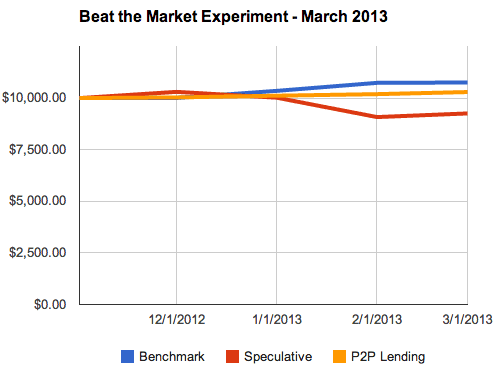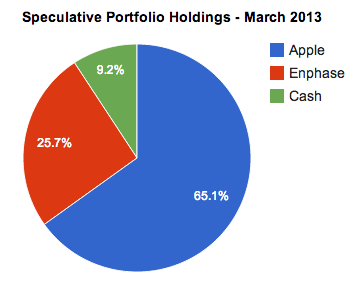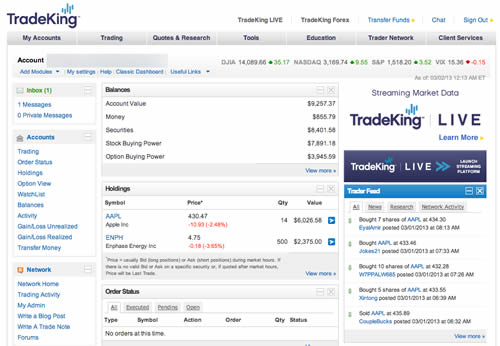Here’s the 2nd piece of the monthly updates for my Beat the Market Experiment, a set of three portfolios started on November 1st, 2012. Since this update is rather boring, let me provide an update on the overall experiment:

- $10,000 Passive Benchmark Portfolio that would serve as both a performance benchmark and an real-world, low-cost portfolio that would be easy to replicate and maintain for DIY investors.
- $10,000 Beat-the-Benchmark Speculative Portfolio that would simply represent the attempts of an “average guy” who is not a financial professional and gets his news from mainstream sources to get the best overall returns possible.
- $10,000 Consumer Loan Speculative Portfolio – Split evenly between LendingClub and Prosper, this portfolio is designed to test out the alternative investment of peer-to-peer loans. The goal is again to beat the benchmark by setting a target return of 8-10% net of defaults.
$10,000 Beat-the-Benchmark Speculative Portfolio as of March 2, 2013. Many people speculate with their money, buying and selling stocks now and then, but they rarely track their performance even though they may brag about their winners. Honest tracking is the primary reason for this “no-rules, just make money” account. I am using a TradeKing account for this portfolio as I’ve had an account with them for a while and am comfortable with their low-cost $4.95 trade structure, free tax-management gain/loss software, and free dividend reinvestment. Here is a screenshot taken from my TradeKing home page 3/2/13 mid-day:
No new activity. I didn’t trade anything last month. I’m sticking with my AAPL pick, while my ENPH holdings are actually up over 25% from when I bought it. Too bad it was only 20% of my portfolio. Here’s a pie chart of my holdings, tracked via Google Docs spreadsheet (2nd tab):

Total value of stocks $8,402
Cash balance: $856
Total portfolio value (3/2/13): $9,258
2013 YTD return: -7.6% (based on $10,019 value on 1/1/13)
Total return since inception (11/1/12): -$742, or -7.4%

 The Best Credit Card Bonus Offers – 2025
The Best Credit Card Bonus Offers – 2025 Big List of Free Stocks from Brokerage Apps
Big List of Free Stocks from Brokerage Apps Best Interest Rates on Cash - 2025
Best Interest Rates on Cash - 2025 Free Credit Scores x 3 + Free Credit Monitoring
Free Credit Scores x 3 + Free Credit Monitoring Best No Fee 0% APR Balance Transfer Offers
Best No Fee 0% APR Balance Transfer Offers Little-Known Cellular Data Plans That Can Save Big Money
Little-Known Cellular Data Plans That Can Save Big Money How To Haggle Your Cable or Direct TV Bill
How To Haggle Your Cable or Direct TV Bill Big List of Free Consumer Data Reports (Credit, Rent, Work)
Big List of Free Consumer Data Reports (Credit, Rent, Work)
Hi Jonathan,
I’m a retired woman who just recently stumbled onto an older blog you put out regarding using passive index funds as opposed to managed funds. it was enlightening to say the least. I have my IRA with Fidelity and they’ve been pushing me to let them manage my money through their PAS investments which has a very high fee and it hasn’t felt right to do it. I am so very grateful to you, for the studies you’ve conducted especially this current “Beat the bench mark” study. It’s helped me decide to take control of my own IRA and use indexed funds balanced in a way that makes sense for my situation. Thank you, keep up the great work.
You mentioned that you might consider trading options in this speculative account. Now that mini-options are supposed to debut this month, do you think that will influence you to trade options on AAPL?
The P2P lending is extremely interesting.
Do you think there’s a case for replacing a small portion of your bonds in your AA with P2P lending? If there is, I imagine it’s a similar to the augment Rick Ferri makes on high-yield funds: periods of low correlation with the board stock market and historically decent returns (risk/return blend somewhere between AAA bonds & equities).
P2P might behavior similar to low quality bonds, but maybe not have the same downsides of high-yield funds, such as call-risk when the interest rate drops. I speculate there is a lower correlation with the boarder bond market and might provide re-balancing opportunities during a bear market. There is no free-lunch of course and if a debtor defaults, it maybe difficult to collect/not worth-it for such small sums. Therefore, P2P and high-yield bond funds might have similar rolling risk/returns but also periods low correlations due the P2P not having the same interest-sensitive call-risk/less sensitivity to secondary market factors and high-yield having less default risk (e.g. a company going through bankruptcy will liquidate the assets to pay issuers backs).
Thoughts on their representative risk profiles?
Great blog! I’m enjoying watching this experiment unfold.
@Patricia – Thanks for the kind words, I believe this is the post that you are referencing:
https://www.mymoneyblog.com/fidelity-portfolio-advisory-service-review-w-actual-holdings.html
I thought it was very illuminating as well; if anyone else wants to send me their holdings in a managed portfolio, I’d be happy to take a look at it.
@Patrick – Perhaps, but I just haven’t gotten around to learning more about options trading.
@John – You raise a lot of good points. Right now, it’s really hard to say how P2P loans will compare to say a junk bond fund. Dealing with consumers directly just seems so much different than companies. I think that in recent years with dropping rates, the junk bond funds have probably done better. But I agree that with rising rates, P2P might have some positives.
As for this particular account, I’m only 4 months in so it’s hard to say how the defaults will add up over time. Yields are definitely higher, but so are defaults. A lot is dependent on LC and Prosper’s credit quality determinations and how they set the interest rates (as opposed to an open marketplace). We’ll see, let’s go 8% net return! 🙂